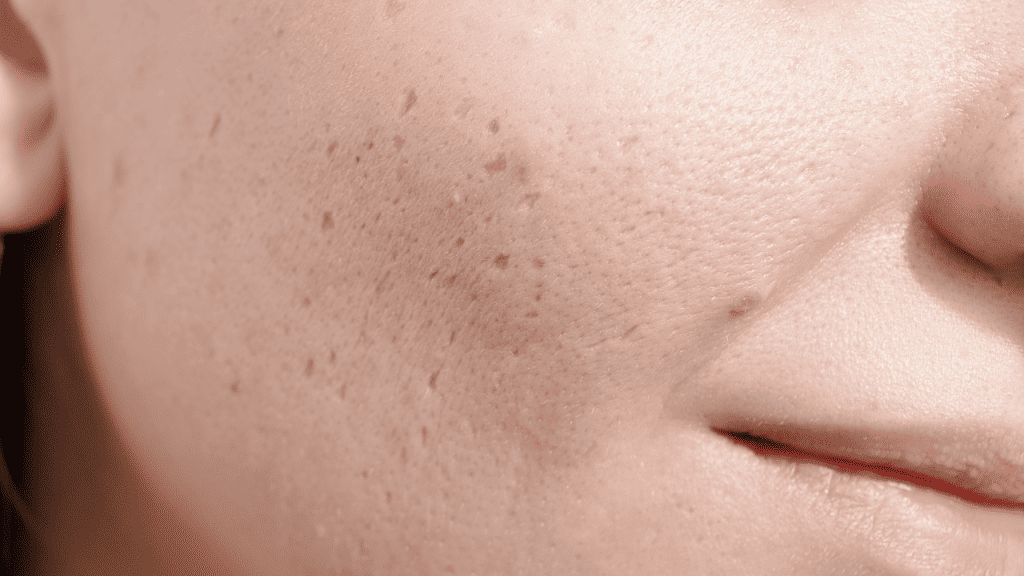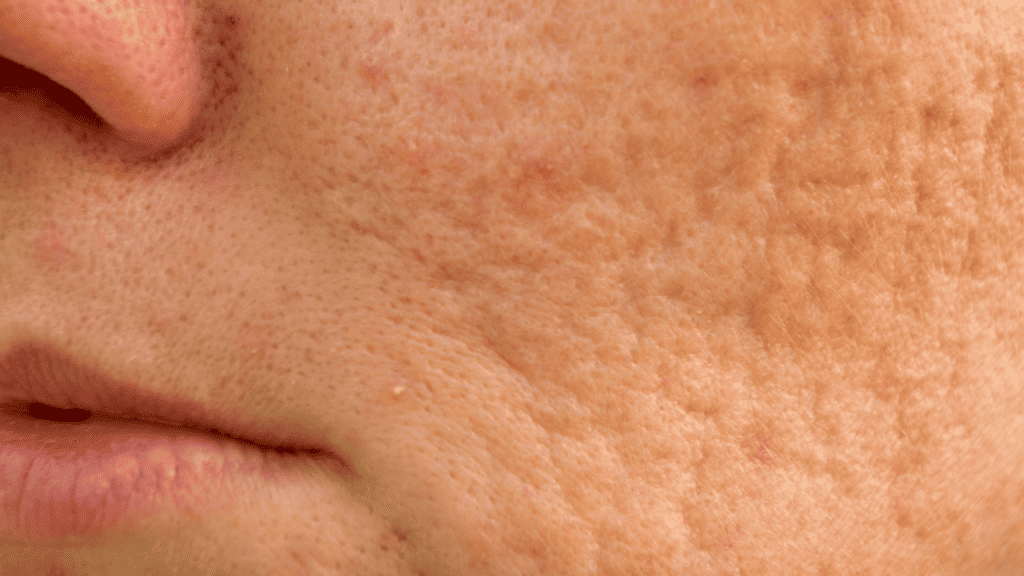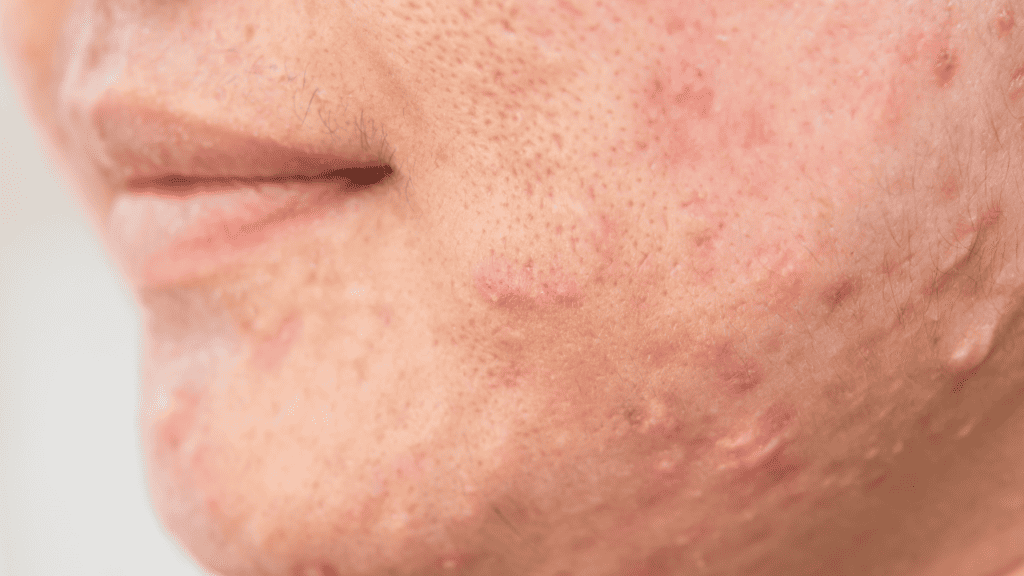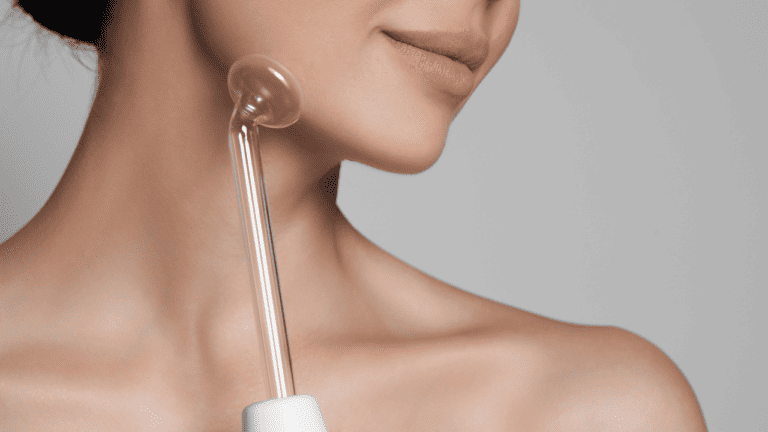Acne scars can be categorized into 4 different types, icepick, boxcar, rolling and keloid scars, and to fade them it requires a mix of professional and at home treatments.
We are here to obtain a thorough understanding of the most effective treatments for each. Our goal is to provide you with a clear thought of how these scars form and the best ways to treat them.
Key takeaways
- Identifying the type of acne scar (icepick, boxcar, rolling, or keloid) is crucial for choosing the most effective treatment.
- Professional treatments, combined with a consistent skincare routine, can significantly improve the appearance of acne scars.
- Preventive measures and early treatment of acne can reduce the risk of scar formation.
The 4 types of Acne Scars
1. Icepick Scars

Description and distinct features
Icepick scars are deep, very narrow scars that extend into the dermis. They appear as small, yet significant, round or oval holes – like an ice pick has punctured the skin. These scars are more common on the cheeks and are among the most challenging to treat due to their depth.
Some people never experience ice pick scars whilst some people are more prone to ice pick scars, this depends on the severity of the acne.
2. Boxcar Scars

Description and distinct features
Boxcar scars are round or oval depressions with steep vertical sides. Wider than icepick scars, they resemble the scars left by chicken pox. They’re caused by widespread acne, collagen destruction, and inflammation. Boxcar scars are most often found on the lower cheeks and jaw.
3. Rolling Scars

Description and Distinct Features
Rolling scars create an appearance of wave-like undulations across the skin. They are wide and shallow. The cause of rolling scars is the fibrous bands that develop between the skin and the subcutaneous tissue below, pulling the epidermis, binding it, and creating the rolling appearance.
Although these are more shallow than icepick scars, they tend to look more visible because they cause the light to reflect unevenly. This is even more obvious under certain lights as acne scars look different depending on lighting conditions.
4. Keloid Scars

Unique Characteristics
Keloid scars are the result of an overly aggressive healing process. They extend beyond the original injury site, forming a raised, thick, and irregular scar. Unlike other acne scars, keloids can grow to be much larger than the wound that caused the scar. They are more common among people with darker skin tones.
Keloid scars are often also more sensitive than regular skin. The skin has over compensated and could feel painful while the keloid scar is growing.
Treatment Options for Acne Scars
How To Fade Icepick Scars
To fade Icepick Scars, targeted treatments such as TCA Cross and Laser Therapy work well. TCA Cross is a method involving highly concentrated trichloroacetic acid which is applied directly into the scars, dermatologists have done this with toothpicks and syringes to precisely aim into the icepick scar. Typically TCA Cross is not as expensive as laser therapy, however it does need more treatments. Not to be done at-home and only in professional settings.
Laser Therapy can help icepick scars, but it depends on the laser. Fully ablative laser resurfacing may not be able to reach the depth needed to treat the icepick scar fully, because the bottom level of the icepick scar may be out of safe reach. Still, Dr Davin Lim a board certified dermatologist, says laser treatment is possible, “look for lasers where the spot size is between 0.75 to about 1.2 mil that way you can deliver the beam precisely into the hole itself of the icepick scar”. The advantage with laser therapy is that it requires less treatments in comparison to TCA Cross.
How To Fade Boxcar Scars
To fade Boxcar scars, dermal fillers work well as they are often not as deep as icepick scars. Dermal fillers involve injecting hyaluronic acid or similar substances that can temporarily elevate these scars.
For a more permanent option to fade Boxcar scars, Subcision is a acknowledged surgical procedure that breaks the fibrous bands causing the scar depression, allowing the skin to lift, and essentially reduce the scar appearance.
How To Fade Rolling Scars
To fade rolling scars, the most common treatments are micro needling and radio frequency. These are treatments that really stimulate collagen production and help to gain a more even surface. For example, micro needling involves using a device covered with tiny, shallow needles to create micro-injuries in the skin, promoting collagen growth.
Microneedling combined with radio frequency enhances collagen growth as radio frequency energy further stimulates collagen and tightens the kin.
How To Fade Keloid Scars
Steroid Injections and Surgery
To Fade keloid scars, steroid injections are often used because they flatten and reduce inflammation. Keloid scars, are raised scars that are usually the hardest to treat. In some cases, keloid scars might need to be removed with surgery, follower by laser therapy or radiation after surgery to minimize chances of reoccurrence.
Prevention and Care
Preventing Acne and Minimizing Scarring
Preventing acne outbreaks is key to reducing the risk of scar formation. Maintaining a consistent skincare routine that includes cleansing, exfoliating, and moisturizing can help. Using non-comedogenic products is essential to avoid clogging pores. Additionally, managing stress, eating a balanced diet, and avoiding excessive sun exposure can contribute to healthier skin.
Conclusion
Navigating the world of acne scars can be challenging, but with the right information and resources, it’s possible to significantly improve their appearance and health of your skin. We’ve discussed various types of scars – icepick, boxcar, rolling, and keloid – and outlined specific treatments that can help in each case.
Keep in mind, the key to effective scar treatment lies in understanding the type of scar and seeking personalized advice from a dermatologist. Prevention and proper skincare also play a crucial role in maintaining your skin’s health. We encourage you to consult a skincare professional to explore the best options for your unique skin needs. Armed with this knowledge, you’re now better equipped to tackle acne scars and embrace a journey towards clearer, more confident skin.
FAQs
Can over-the-counter products effectively treat acne scars?
While over-the-counter products can help with mild scarring, professional treatments are usually required for significant improvements, especially for deeper scars.
How long does it take to see results from acne scar treatments?
Results vary depending on the type of treatment and scar; some treatments show improvement within weeks, while others may take several months.
Are acne scar treatments permanent?
Many treatments offer long-lasting results, but maintenance treatments may be necessary, especially for keloid scars, which have a tendency to recur.






